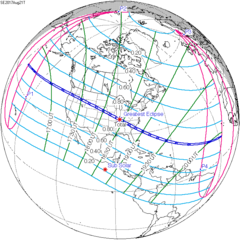|
August 2026 lunar eclipse
A partial lunar eclipse will occur at the Moon’s ascending node of orbit on Friday, August 28, 2026,[1] with an umbral magnitude of 0.9319. A lunar eclipse occurs when the Moon moves into the Earth's shadow, causing the Moon to be darkened. A partial lunar eclipse occurs when one part of the Moon is in the Earth's umbra, while the other part is in the Earth's penumbra. Unlike a solar eclipse, which can only be viewed from a relatively small area of the world, a lunar eclipse may be viewed from anywhere on the night side of Earth. Occurring about 6 days after perigee (on August 22, 2026, at 4:20 UTC), the Moon's apparent diameter will be larger.[2] This lunar eclipse will be the last of an almost tetrad, with the others being on March 14, 2025 (total); September 8, 2025 (total); and March 3, 2026 (total). VisibilityThe eclipse will be completely visible over North and South America, seen rising over the central Pacific Ocean and setting over Africa, Europe, and the Middle East.[3]
Eclipse detailsShown below is a table displaying details about this particular solar eclipse. It describes various parameters pertaining to this eclipse.[4]
Eclipse seasonThis eclipse is part of an eclipse season, a period, roughly every six months, when eclipses occur. Only two (or occasionally three) eclipse seasons occur each year, and each season lasts about 35 days and repeats just short of six months (173 days) later; thus two full eclipse seasons always occur each year. Either two or three eclipses happen each eclipse season. In the sequence below, each eclipse is separated by a fortnight.
Related eclipsesEclipses in 2026
Metonic
Tzolkinex
Half-Saros
Tritos
Lunar Saros 138
Inex
Triad
Lunar eclipses of 2024–2027
Saros 138Lunar saros series 138 has 26 total eclipses between September 7, 2044 and March 24, 2369. The longest eclipse will be on January 7, 2243, and last for 102 minutes. Partial eclipses will occur between June 24, 1918 and August 13, 2603. Penumbral eclipses will occur between October 15, 1521 and March 30, 2982. [5] Metonic seriesThe Metonic cycle repeats nearly exactly every 19 years and represents a Saros cycle plus one lunar year. Because it occurs on the same calendar date, the Earth's shadow will be in nearly the same location relative to the background stars.
Half-Saros cycleA lunar eclipse will be preceded and followed by solar eclipses by 9 years and 5.5 days (a half saros).[6] This lunar eclipse is related to two total solar eclipses of Solar Saros 145.
See alsoNotes
External links
|
|||||||||||||||||||||||||||||||||||||||||||||||||||||||||||||||||||||||||||||||||||||||||||||||||||||||||||||||||||||||||||||||||||||||||||||||||||||||||||





























